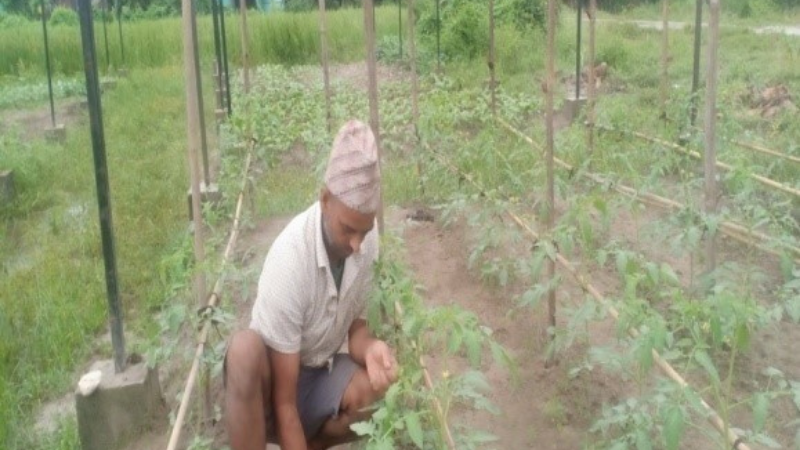by Nepal Agriculture Cooperative Central Federation Limited (NACCFL)
Description
Punya Ghimire, a small farmer of Maharanijhoda, Jhapa had been practising non-organic farming for 8 years. After testing the soil of his land, the farmer noticed that the soil was being degraded and acidic due to overuse of fertilizers. For this reason, he decided to be trained in organic agriculture and started farming accordingly, adopting agricultural practices with the aim to mitigate climate change:
- Seed treatment: utilization of organic methods for treatment of seeds such as hot water treatments, disinfectants, herbal
treatments, treatments with Trichoderma, usage of salt for rice seeds etc.; - Soil treatment: application of well-decomposed farm yield manure, vermicompost, and compost;
- Weed management: manual or mechanical control of weeds. No use of weedicide on the farm;
- Fertilizer management: well-decomposed farm yield manure is applied in order to prevent diseases. Organic fertilizers, such as compost, have been used for crops. Different organic fertilizers have been used as per recommended doses. Different types of beneficial microorganisms such as Trichoderma and rhizobium have been incorporated in the soil;
- Pesticides and insecticides management: integrated pest management practices are carried out on the farm. Biopesticides and insecticides have been preferred for the management of pests. Several types of insect traps have been used on the farm. Different beneficial microorganisms like Bacillus Thuringiensis, egg parasite Trichogramma, Beauveria Bassiana have been used to manage whiteflies, thrips, aphids and weevils. Lecanicillium spp. are deployed against whiteflies, thrips and aphids. Metarhizium spp. are used against pests including beetles, locusts and other grasshoppers, Hemiptera, and spider mites. Paecilomyces Fumosoroseus is effective against whiteflies, thrips and aphids;
- Diseases control: beneficial microorganisms such as Bacillus subtilis and Trichoderma Viridae are also used to control plant pathogens. Crop rotation, intercropping have also been practised in the field for the control of diseases. Different home-made bio-fungicides, bio-bactericides have been used to control diseases.
Results
Organic agriculture is taken as one of the appropriate farming systems which have twin objective of climate change mitigation and adaptation. Organic farming mainly depends upon crop rotations, use of crop residues, well-decomposed farm yield manure, mineral rock and biofertilizer, natural pesticides and insecticides. Organic agriculture reduces the emission of greenhouse gases. It is because of the avoidance of chemical fertilizers on the farm. Thus, it enhances the carbon content of the soil. Organic farming is also more energy-efficient. It is reported that the use of energy is 20 to 50% less in comparison to the conventional farming system (Pimentel et al., 2005; Schader et al., 2011 and Muller) As organic farming avoids the use of insecticides, pesticides, hormones, etc. it helps in mitigating the climatic change. Organic farming easily sequesters carbon in the soil. (Panwar et al., 2010; IFOAM, 2009).
Climate smartness*
As described in the project results, practices promoted contribute to all CSA pillars (adaptation, mitigation and productivity), because these practices increase adaptive capacity, yields and incomes from agricultural systems, as well as, support the reduction of greenhouse gas (GHG) emissions and increase soil carbon sequestration.
The project may benefit from including other practices (some of them in CIAT et al., 2017), which can be identified by the farmers themselves if participatory processes for building capacity are put in place. This may be done through strengthening farmers understanding of historic and future climate information and its effect on agricultural systems.
Such processes may increase farmers resilience in terms of providing the tools for better-informed decision-making processes which may be tailored on their needs, socioeconomic and environmental contexts.
*This is done in the framework of climate-smart agriculture (CSA) approach. Climate-smartness in agriculture means understanding impacts of climate change and variability along with the agricultural activity, which includes the planning of what crop to plant, when to plant, what variety to plant and what type of management practices are needed to reduce the impact on the environment (e.g. emissions reduction), maintain or increase productivity (e.g. yields) while increasing resilience and improving livelihoods.


